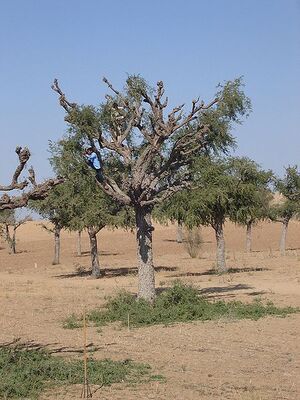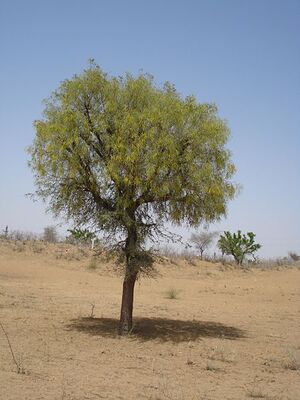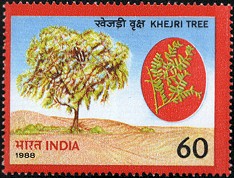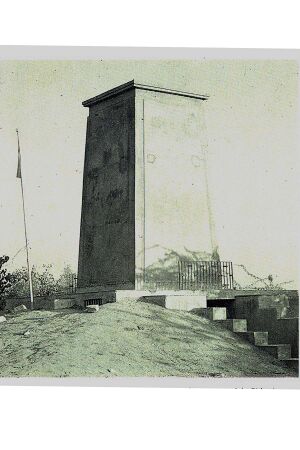Khejri
| Author:Laxman Burdak, IFS (R) |
Khejri (खेजड़ी) (Prosopis cineraria) is a tree species found in Rajasthan, Haryana, Uttar Pradesh, Punjab, Madhya Pradesh and Gujarat and also in Pakistan.
Contents
Geographical Distribution
Its Geographical distribution is almost the same as is the distribution of Jats in India and Pakistan. It is the state tree of Rajasthan and the provincial tree of the Sindh provincial region of Pakistan.
It is a species of flowering tree in the pea family, Fabaceae, that is native to arid portions of Western Asia and South Asia and Thar Deserts.
Alternate names
Common names in various languages include:
- Prosopis cineraria (Scientific name)
- Khejri (खेजड़ी )(Rajasthan)
- Jant (जांट) (Rajasthan)
- Janti (जांटी)(Rajasthan and Haryana),
- Sangri (सांगरी) (Rajasthan),
- Chhonkara(छोंकरा) (Western Uttar Pradesh),
- Jand (जंड)(Punjabi),
- Kandi (Sindh),
- Banni (Kannada),
- Vanni (Tamil),
- Sami (समी)/ Shami (शमी/ शमीवृक्ष) - In Sanskrit,
- Sumri (Gujarat).
- Ghaf (Arabic language),
Mention by Panini
Shami (शमी) is name of a place mentioned by Panini in Ashtadhyayi under Madhvadi (मध्वादि) (4.2.86) group. [1]
Shami (शमी) is mentioned by Panini in Ashtadhyayi. [2]
Shamira (शमीर), a small shami tree, is mentioned by Panini in Ashtadhyayi. [3]
Stamp on Khejri
Indian Postal Department issued a Postal Stamp on Khejri in 1988.
Uses
- Prosopis cineraria provides wood of construction class. It is used for house-building, chiefly as rafters, posts scantlings, doors and windows, and for well construction water pipes, upright posts of Persian wheels, agricultural implements and shafts, spokes, fellows and yoke of carts.
- It can also be used for small turning work and tool-handles. Container manufacturing is another important wood-based industry, which depends heavily on desert-grown trees.
- Prosopis cineraria is much valued as a fodder tree. The trees are heavily lopped particularly during winter months when no other green fodder is available in the dry tracts. There is a popular saying that death will not visit a man, even at the time of a famine, if he has a Prosopis cineraria, a goat and a camel, since the three together are some what said to sustain a man even under the most trying condition. The forage yield per tree varies a great deal. On an average, the yield of green forage from a full grown tree is expected to be about 60 kg with complete lopping having only the central leading shoot, 30 kg when the lower two third crown is lopped and 20 kg when the lower one third crown is lopped. The leaves are of high nutritive value. Feeding of the leaves during winter when no other green fodder is generally available in rain-fed areas is thus profitable. The pods have a sweetish pulp and are also used as fodder for livestock.
- Prosopis cineraria is most important top feed species providing nutritious and highly palatable green as well as dry fodder, which is readily eaten by camels, cattle, sheep and goats, constituting a major feed requirement of desert livestock. Locally it is called Loong.
- Pods are locally called sangar or sangri. The dried pods locally called Kho-Kha are eaten. Dried pods also form rich animal feed, which is liked by all livestock. Green pods also form rich animal feed, which is liked by drying the young boiled pods. They are also used as famine food and known even to prehistoric man. Even the bark, having an astringent bitter taste, was reportedly eaten during the severe famine of 1899 and 1939. Pod yield is nearly 1.4 quintals of pods/ha with a variation of 10.7% in dry locations.
- Prosopis cineraria wood is reported to contain high calorific value and provide high quality fuel wood.
- The lopped branches are good as fencing material.
- Its roots also encourage nitrogen fixation, which produces higher crop yields.
कैर सांगरी की सब्जी
कैर सांगरी राजस्थान की ज्यादा तेल और ज्यादा मसाले के साथ बनने वाली चटपटी सब्जी है, कैर छोटे छोटे गोल गोल होते हैं, और सांगरी 2-4 इंच लम्बी पतली फली होती हैं. कैर और सांगरी के पेड़ राजस्थान में मिलते हैं. वहां के लोग सीजन में ताजा फलों से कैर, सांगरी की सब्जी बनाते हैं और बाद के लिये कैर और सांगरी को अच्छी तरह सुखा कर रख लिया जाता है, जब भी सब्जी बनानी हो इसे पानी या छाछ में भिगो कर बना लिया जाता है. सूखी हुई कैर सांगरी बड़े शहरों में किसी बड़ी किराना स्टोर पर मिल जाते हैं, कैर सांगरी को राजस्थाने की मेवा भी कहा जाता है. कैर सांगरी इसका स्वाद इतना अच्छा और अलग हैं कि आप इसे बनायेंगे तभी जान पायेंगे.
आवश्यक सामग्री
सांगरी - 1 कप कैर - 1/4 कप तेल - 4-5 टेबल स्पून हरा धनियां - 2-3 टेबल स्पून किशमिश - 2-3 टेबल स्पून जीरा - आधा छोटी चम्मच हींग - 2 पिंच साबुत लाल मिर्च - 3-4 लाल मिर्च पाउडर - 1 छोटी चम्मच गरम मसाला - आधा छोटी चम्मच नमक - 1.5 छोटी चम्मच या स्वादानुसार धनियां पाउडर - 1.5 छोटी चम्मच अमचूर पाउडर - 1 छोटी चम्मच हल्दी पाउडर - आधा छोटी चम्मच
विधि
केर और सांगरी को अच्छी तरह साफ करके, 4-5 बार अच्छी तरह पानी से धो लीजिये, और अलग अलग 8-10 घंटे या रात भर के लिये पानी में भिगो दीजिये. इसके बाद केर सांगरी को पानी से निकाल लीजिये और 1-2 बार और धो लीजिये.
भीगे हुये केर सांगरी को उबालने के लिये कुकर में डालिये और 2 कप पानी डालिये और कुकर बन्द कर दीजिये, कुकर में एक सीटी आने के बाद, गैस धीमी कर लीजिये और केर सांगरी को धीमी गैस पर 2-3 मिनिट और उबलने दीजिये. गैस बन्द कर दीजिये, कुकर का प्रेशर खतम होने पर कुकर खोलिये, कैर सांगरी उबल कर तैयार हैं, कैर सांगरी को छ्लनी में डाल कर निकालिये, अतिरिक्त पानी हटा दीजिये. साफ पानी से सब्जी को और 1-2 बार धो लीजिये. कैर सांगरी सब्जी बनाने के लिये तैयार है.
सब्जी बनाने के लिये कढ़ाई में तेल डालकर गरम कीजिये, जीरा डालिये, हींग भी डाल दीजिये, जीरा भुनने के बाद, हल्दी पाउडर, धनियां पाउडर, साबुत लाल मिर्च डालिये, मसाले को थोड़ा सा भून लीजिये. कैर सांगरी डाल दीजिये, लाल मिर्च पाउडर, अमचूर पाउडर, गरम मसाला, नमक और किशमिश डाल दीजिये और सब्जी को चलाते हुये 3-4 मिनिट तक पकाइये. कैर सांगरी की सब्जी बन कर तैयार हो गई है, थोड़ा सा हरा धनियां डालकर मिला दीजिये.
सब्जी को प्याले में निकाल लीजिये, ऊपर से हरा धनियां डालकर गार्निस कीजिये. कैर सांगरी की स्वादिष्ट सब्जी को पूरी या परांठे के साथ सर्व कीजिये और खाइये. कैर सांगरी की सब्जी को फ्रिज में रखकर 3-4 दिन तक खाया जा सकता है.
सुझाव:
कैर और सांगरी को छाछ में भिगो कर भी सब्जी बना सकते हैं, कैर और सांगरी को छाछ (मठा )में भिगो दीजिये और मठे से निकाल कर, धोकर, उपरोक्त तरीके से सब्जी बनाकर तैयार कर लीजिये.
Khejri in Jat traditions
- Mugdaṇā (मुगदणा) - green and dried twigs of khejri tree brought from farm on a cart on the day of baan which are worshiped by mother or sister of a boy or girl prior to marriage.
- Māndā (मांडा) - a pole made of khejadi tree put on the day of marriage of a girl
Khejarli movement for saving trees
Khejarli or Khejadli is a village in Jodhpur district of Rajasthan, India. The name of the town is derived from Khejri (Prosopis cineraria) trees, which were in abundance in the village. In this village 363 Bishnois had to sacrifice their lives in 1730 AD for protecting green trees.
Origin of Chipko movement
It is the place where Chipko movement originated in India. It was a Tuesday, black Tuesday in Khejadli. 10th day of the bright fortnight of the month Bhadra (Indian lunar Calendar) in 1730 A.D. Amrita Devi a mother of three daughters viz. Asu, Ratni and Bhagu bai was at home with her daughters. Suddenly, she camae to know that many people had descended in their otherwise sleepy village. It was a party of Maharaja Abhay Singh, Ruler of Marwar (Jodhpur) state who wanted to fell green Khejri (Prosopis cineraria) trees to burn lime for the construction of his new palace. Since there was a lot of greenery in the Bishnoi villages even in the middle of Thar Desert, the king ordered his men to get the woods from Khejri trees.
Amrita Devi sacrificed for saving trees
Amrita Devi protested against King's men attempting to cut green trees as it was prohibited in Bishnoi religion. The malevolent feudal party told her that if she wanted the trees to be spared, she should give them money as bribe. She refused to acknowledge this demand and told them that she would consider it as an act of ignominy and insult to her religious faith. She said that she would rather give away her life to save the green trees. It is at that stage she spoke these words:
- "Sar sāntey rūkh rahe to bhī sasto jān"
- (If a tree is saved even at the cost of one's head, it's worth it)
Saying these words, she offered her head! The axes, which were brought to cut the trees, severed her head from her trunk. The three young girls Asu, Ratni and Bhagu were not daunted, and offered their heads too!!
Mass movement to protect trees
The news spread like wildfire. Bishnois gathered and sent summons to 83 Bishnoi villages to come and decide on the next course of action. Since the supreme sacrifice by those four had not satisfied the royal party, and the felling of green trees was continued, it was decided that for every green tree to be cut, one Bishnoi volunteer would sacrifice his/ her life. In the beginning, old people voluntarily started holding the trees to be cut in an embrace as in the Chipko movement of 20th Century in Uttar Pradesh (India).
363 Bishnois became martyrs
In this way many valiant old persons gave away their lives, but it failed to have the desired impact. Moreover, the Hakim (Royal party's leader) taunted the Bishnois that in this manner they were offering unwanted old persons. Soon, young men, women, including recently married ones and children were sacrificing themselves in a similar manner.
There was intense pandemonium. It completely shook the tree-felling party, headed by their leader Girdhar Das Bhandari (Hakim), they left for Jodhpur with their mission unfulfilled and told the Maharaja about what had happened. As soon as he learnt it, he ordered stoppage of the felling of trees.
By that time, Three Hundred and Sixty Three (363) Bishnois, young and old, men and women, married and unmarried, rich and poor had already become martyrs. Gotra wise number of these martyrs was as under: Achra (1), Badaderi (1), Badiyani (1), Chotiya (1), Degipal (1), Dudan (1), Geela (1), Goyal (1), Janwar (1), Jewlia (1), Jhuria (1), Kalirani (1), Khavi (1), Khichar (1), Kupasiya (1), Lamba (1), Maal (1), Ranwa (1), Sigar (1), Tandi (1), Vasu (1),
Adina (2), Bhadiawas (2), Bola (2), Jhangu (2), Manju (2), Punia (2), Thalod (2),
Bhanwala (3), Burdak (3), Chahar (3), Dhatarwal (3), Potalia (3), Rahad (3), Siyol (3),
Bhadia (4), Dhayal (4), Isram (4), Karhwasra (4),
Bhangarwas (5), Dukiya (5),
Khava (6), Khileri (6), Lol (6), Nain (6), Sahu (6), Sinwar (6),
Dudi (10), Kaswan (10), Khod (10), Khokhar (10), Panwar (10),
Asiagh (13), Not clear (22),
Jani (15),
Saran (18),
Babal (22),
Beniwal (25),
Bhadu (26),
Godara (37)
Note: Read above Gotras as under: Badaderi भडाडरा, Badiyani भड़िया, Degipal डिगिवाल, Dudan डूडी, Khavi = खावा, Bhadiawas = भडि़यासा, Bhanwala = भांवला, Bhangarwas = भंगरवा, Sinwar = सींवर, Khava = खावा
List of Khejarli martyrs
The complete list of Khejarli martyrs can be seen here -
The tree felling banned
Honouring the courage of the Bishnoi community, the ruler of Jodhpur, Maharaja Abhay Singh, apologized for the mistake committed by his officials and issued a royal decree, engraved on a copper plate ordering the following:
- (A) All cutting of green trees and hunting of animals within the revenue boundaries of Bishnoi villages was strictly prohibited.
- (B) It was also ordered that if by mistake any individual violated this order, he would be prosecuted by state and a severe penalty imposed.
- (C) Even the members of ruling family did not shoot animals in or even near the Bishnoi's Village
Although, Bishnois paid a huge price for saving a few trees, this incident had inspired, and will continue to do so in future, many others to fight and protect trees and wild life.
See also
खेजड़लो - For information in Hindi
References
- ↑ V. S. Agrawala: India as Known to Panini, 1953, p.505
- ↑ V. S. Agrawala: India as Known to Panini, 1953, p. 212, 380
- ↑ V. S. Agrawala: India as Known to Panini, 1953, p.212



